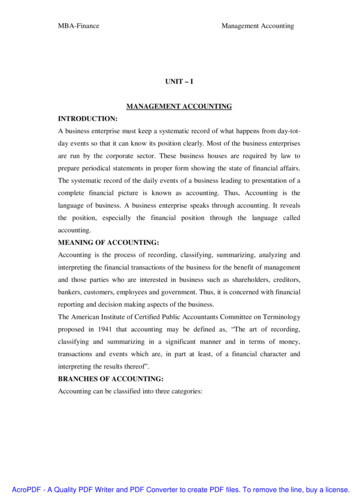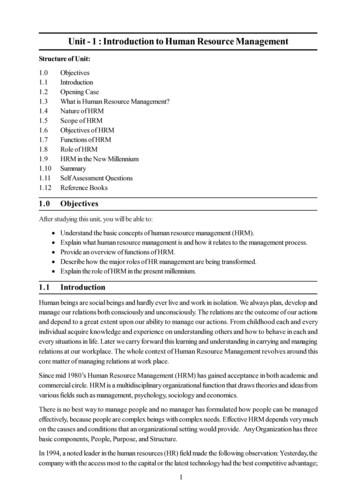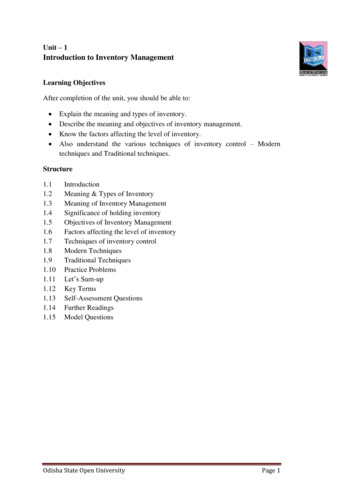
Transcription
MBA-FinanceManagement AccountingUNIT – IMANAGEMENT ACCOUNTINGINTRODUCTION:A business enterprise must keep a systematic record of what happens from day-totday events so that it can know its position clearly. Most of the business enterprisesare run by the corporate sector. These business houses are required by law toprepare periodical statements in proper form showing the state of financial affairs.The systematic record of the daily events of a business leading to presentation of acomplete financial picture is known as accounting. Thus, Accounting is thelanguage of business. A business enterprise speaks through accounting. It revealsthe position, especially the financial position through the language calledaccounting.MEANING OF ACCOUNTING:Accounting is the process of recording, classifying, summarizing, analyzing andinterpreting the financial transactions of the business for the benefit of managementand those parties who are interested in business such as shareholders, creditors,bankers, customers, employees and government. Thus, it is concerned with financialreporting and decision making aspects of the business.The American Institute of Certified Public Accountants Committee on Terminologyproposed in 1941 that accounting may be defined as, “The art of recording,classifying and summarizing in a significant manner and in terms of money,transactions and events which are, in part at least, of a financial character andinterpreting the results thereof”.BRANCHES OF ACCOUNTING:Accounting can be classified into three categories:AcroPDF - A Quality PDF Writer and PDF Converter to create PDF files. To remove the line, buy a license.
MBA-FinanceManagement Accounting1. Financial Accounting2. Cost Accounting, and3. Management AccountingFINANCIAL ACCOUNTING:The term ‘Accounting’ unless otherwise specifically stated always refers to‘Financial Accounting’. Financial Accounting is commonly carries on in the generaloffices of a business. It is concerned with revenues, expenses, assets and liabilitiesof a business house. Financial Accounting has two-fold objective, viz,1. To ascertain the profitability of the business, and2. To know the financial position of the concern.NATURE AND SCOPE OF FINANCIAL ACCOUNTING:Financial accounting is a useful tool to management and to external users such asshareholders, potential owners, creditors, customers, employees and government. Itprovides information regarding the results of its operations and the financial statusof the business. The following are the functional areas of financial accounting:1. Dealing with financial transactions:Accounting as a process deals only with those transactions which are measurable interms of money. Anything which cannot be expressed in monetary terms does notform part of financial accounting however significant it is.2. Recording of information:Accounting is an art of recording financial transactions of a business concern. Thereis a limitation for human memory. It is not possible to remember all transactions ofthe business. Therefore, the information is recorded in a set of books called Journaland other subsidiary books and it is useful for management in its decision makingprocess.AcroPDF - A Quality PDF Writer and PDF Converter to create PDF files. To remove the line, buy a license.
MBA-FinanceManagement Accounting3. Classification of Data:The recorded data is arranged in a manner so as to group the transactions of similarnature at one place so that full information of these items may be collected underdifferent heads. This is done in the book called ‘Ledger’. For example, we mayhave accounts called ‘Salaries’, ‘Rent’, ‘Interest’, Advertisement’, etc. To verifythe arithmetical accuracy of such accounts, trial balance is prepared.4. Making Summaries:The classified information of the trial balance is used to prepare profit and lossaccount and balance sheet in a manner useful to the users of accountinginformation. The final accounts are prepared to find out operational efficiency andfinancial strength of the business.5. Analyzing:It is the process of establishing the relationship between the items of the profit andloss account and the balance sheet. The purpose is to identify the financial strengthand weakness of the business. It also provides a basis for interpretation.6. Interpreting the financial information:It is concerned with explaining the meaning and significance of the relationshipestablished by the analysis. It should be useful to the users, so as to enable them totake correct decisions.7. Communicating the results:The profitability and financial position of the business as interpreted above arecommunicated to the interested parties at regular intervals so as to assist them tomake their own conclusions.LIMITATIONS OF FINANCIAL ACCOUNTING:Financial accounting is concerned with the preparation of final accounts. Thebusiness has become so complex that mere final accounts are not sufficient inAcroPDF - A Quality PDF Writer and PDF Converter to create PDF files. To remove the line, buy a license.
MBA-FinanceManagement Accountingmeeting financial needs. Financial accounting is like a post-mortem report. At themost it can reveal what has happened so far, but it can not exercise any control overthe past happenings. The limitations of financial accounting are as follows:1. It records only quantitative information.2. It records only the historical cost. The impact of future uncertainties has noplace in financial accounting.3. It does not take into account price level changes.4. It provides information about the whole concern. Product-wise, processwise, department-wise or information of any other line of activity cannot beobtained separately from the financial accounting.5. Cost figures are not known in advance. Therefore, it is not possible to fix theprice in advance. It does not provide information to increase or reduce theselling price.6. As there is no technique for comparing the actual performance with that ofthe budgeted targets, it is not possible to evaluate performance of thebusiness.7. It does not tell about the optimum or otherwise of the quantum of profitmade and does not provide the ways and means to increase the profits.8. In case of loss, whether loss can be reduced or converted into profit bymeans of cost control and cost reduction? Financial accounting does notanswer this question.9. It does not reveal which departments are performing well? Which ones areincurring losses and how much is the loss in each case?10. It does not provide the cost of products manufactured11. There is no means provided by financial accounting to reduce the wastage.AcroPDF - A Quality PDF Writer and PDF Converter to create PDF files. To remove the line, buy a license.
MBA-FinanceManagement Accounting12. Can the expenses be reduced which results in the reduction of product costand if so, to what extent and how? No answer to these questions.13. It is not helpful to the management in taking strategic decisions likereplacement of assets, introduction of new products, discontinuation of anexisting line, expansion of capacity, etc.14. It provides ample scope for manipulation like overvaluation orundervaluation. This possibility of manipulation reduces the reliability.15. It is technical in nature. A person not conversant with accounting has littleutility of the financial accounts.COST ACCOUNTING:An accounting system is to make available necessary and accurate information forall those who are interested in the welfare of the organization. The requirements ofmajority of them are satisfied by means of financial accounting. However, themanagement requires far more detailed information than what the conventionalfinancial accounting can offer. The focus of the management lies not in the past buton the future.For a businessman who manufactures goods or renders services, cost accounting isa useful tool. It was developed on account of limitations of financial accounting andis the extension of financial accounting. The advent of factory system gave animpetus to the development of cost accounting.It is a method of accounting for cost. The process of recording and accountingfor all the elements of cost is called cost accounting.The Institute of Cost and Works Accountants, London defines costing as, “theprocess of accounting for cost from the point at which expenditure is incurred orcommitted to the establishment of its ultimate relationship with cost centres andcost units. In its wider usage it embraces the preparation of statistical data, theAcroPDF - A Quality PDF Writer and PDF Converter to create PDF files. To remove the line, buy a license.
MBA-FinanceManagement Accountingapplication of cost control methods and the ascertainment of the profitability ofactivities carried out or planned”.The Institute of Cost and Works Accountants, India defines cost accounting as,“the technique and process of ascertainment of costs. Cost accounting is the processof accounting for costs, which begins with recording of expenses or the bases onwhich they are calculated and ends with preparation of statistical data”.To put it simply, when the accounting process is applied for the elements of costs(i.e., Materials, Labour and Other expenses), it becomes Cost Accounting.OBJECTIVES OF COST ACCOUNTING:Cost accounting was born to fulfill the needs of manufacturing companies. It is amechanism of accounting through which costs of goods or services are ascertainedand controlled for different purposes. It helps to ascertain the true cost of everyoperation, through a close watch, say, cost analysis and allocation. The mainobjectives of cost accounting are as follows:1. Cost Ascertainment2. Cost Control3. Cost Reduction4. Fixation of Selling Price5. Providing information for framing business policy.1. Cost Ascertainment:The main objective of cost accounting is to find out the cost of product, process,job, contract, service or any unit of production. It is done through various methodsand techniques.2. Cost Control:The very basic function of cost accounting is to control costs. Comparison of actualcost with standards reveals the discrepancies (Variances). The variances revealAcroPDF - A Quality PDF Writer and PDF Converter to create PDF files. To remove the line, buy a license.
MBA-FinanceManagement Accountingwhether cost is within control or not. Remedial actions are suggested to control thecosts which are not within control.3. Cost Reduction:Cost reduction refers to the real and permanent reduction in the unit cost of goodsmanufactured or services rendered without affecting the use intended. It can bedone with the help of techniques called budgetary control, standard costing,material control, labour control and overheads control.4. Fixation of Selling Price:The price of any product consists of total cost and the margin required. Cost dataare useful in the determination of selling price or quotations. It provides detailedinformation regarding various components of cost. It also provides information interms of fixed cost and variable costs, so that the extent of price reduction can bedecided.5. Framing business policy:Cost accounting helps management in formulating business policy and decisionmaking. Break even analysis, cost volume profit relationships, differential costing,etc are helpful in taking decisions regarding key areas of the business likea. Continuation or discontinuation of productionb. Utilization of capacityc. The most profitable sales mixd. Key factore. Export decisionf. Make or buyg. Activity planning, etc.AcroPDF - A Quality PDF Writer and PDF Converter to create PDF files. To remove the line, buy a license.
MBA-FinanceManagement AccountingNATURE AND SCOPE OF COST ACCOUNTING:Cost accounting is concerned with ascertainment and control of costs. Theinformation provided by cost accounting to the management is helpful for costcontrol and cost reduction through functions of planning, decision making andcontrol. Initially, cost accounting confined itself to cost ascertainment andpresentation of the same mainly to find out product cost. With the introduction oflarge scale production, the scope of cost accounting was widened and providinginformation for cost control and cost reduction has assumed equal significancealong with finding out cost of production. To start with cost accounting was appliedin manufacturing activities but now it is applied in service organizations,government organizations, local authorities, agricultural farms, extractive industriesand so on.Cost accounting guides for ascertainment of cost of production. Cost accountingdiscloses profitable and unprofitable activities. It helps management to eliminate theunprofitable activities. It provides information for estimate and tenders. It disclosesthe losses occurring in the form of idle time spoilage or scrap etc. It also provides aperpetual inventory system. It helps to make effective control over inventory andfor preparation of interim financial statements. It helps in controlling the cost ofproduction with the help of budgetary control and standard costing. Cost accountingprovides data for future production policies. It discloses the relative efficiencies ofdifferent workers and for fixation of wages to workers.LIMITATIONS OF COST ACCOUNTING:i)ii)It is based on estimation: as cost accounting relies heavily onpredetermined data, it is not reliable.No uniform procedure in cost accounting: as there is no uniformprocedure, with the same information different results may bearrived by different cost accounts.AcroPDF - A Quality PDF Writer and PDF Converter to create PDF files. To remove the line, buy a license.
MBA-Financeiii)iv)v)vi)vii)Management AccountingLarge number of conventions and estimate: There are number ofconventions and estimates in preparing cost records such as materialsare issued on an average (or) standard price, overheads are chargedon percentage basis, Therefore, the profits arrived from the costrecords are not
Financial Accounting is commonly carries on in the general offices of a business. It is concerned with revenues, expenses, assets and liabilities of a business house. Financial Accounting has two-fold objective, viz, 1. To ascertain the profitability of the business, and 2. To know the financial position of the concern. NATURE AND SCOPE OF FINANCIAL ACCOUNTING:











